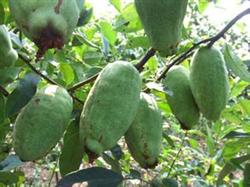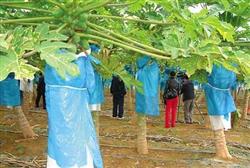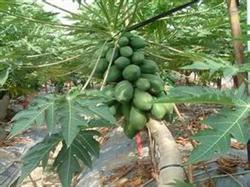Control of brown rot of papaya

Symptoms: Brown rot mainly harms fruits, but also flowers and tender shoots. Fruit disease, the initial brown nearly round small spots, and then with the development of disease, the spots continue to expand, when the conditions are appropriate, the spots quickly expand the whole fruit surface, and gradually extend to the flesh, serious, so that the whole fruit rot. After losing water, the diseased fruit becomes brown stiff fruit, hangs on the branches, does not fall for a long time, the pathogen on the flower stalk or fruit infects the branches, forms brown ulcer spots, affects the normal transportation of nutrients and water, inhibits the growth and development of the branches, and causes the branches to die. 2. Pathogenesis rule: The disease belongs to fungus disease, and its asexual generation belongs to botrytis of subphylum Hemiphyta. The pathogen overwinters on the dead fruit, and the pathogen can also infect the diseased branch after overwintering. In the spring of the following year, after the temperature rises, the pathogens on the diseased fruits and branches produce conidia, which are transmitted by wind and rain. Around early May, when the young fruit formed, most of the bacteria invaded from the wound of the fruit. Therefore, heavy insect pests, insect damage more brown rot is also serious. Early or more rainfall years, early and heavy disease, low-lying cultivation land, vulnerable to waterlogging, weak tree vigor is also suitable for disease. Fruit expansion period, in case of storm, hail and other natural disasters, to the fruit surface caused by more wounds, but also conducive to the invasion of bacteria and disease. 3. Prevention and control methods 1. Treatment of sick and disabled bodies. After harvest, papaya combined with winter pruning, pruning diseased branches, removing diseased fruits, concentrated burning, can effectively reduce overwintering bacteria source. 2. Chemical control. In early spring, before papaya sprouts, spray 1 time of 5 degrees of stone sulfur mixture;3-4 months after papaya blossoms to before fruit harvest, spray 50% carbendazim 500 times or 50% methyl thiophane 800 times every 10-15 days, spray 2-3 times continuously, and can also cure leaf diseases. 3, insect injury. The peach moth is an important pest that harms papaya fruit. In mid-to-late June, when papaya fruit expands, female moths lay eggs in the hollow of fruit stalk and the gap between the joints. After hatching, the larvae bite through the pericarp and bore into the fruit. It not only eats pulp vertically and horizontally, but also causes insect wounds, which is conducive to the invasion of germs. Control method: spray 90% crystal trichlorfon 1000 times solution or fenitrothion emulsion 1500 times solution every 7 days for 3 times in succession during larva incubation period.
- Prev

There are ways to protect papaya from cold.
Papaya is a tropical crop, like hot climate, avoid low-temperature frost. Freezing injury occurs when the temperature is lower than 5 ℃. It is very important to take the following measures to prevent freezing: re-application of overwintering fertilizer. Each tree is treated with 10kg of organic fertilizer mixed with mature human and animal manure and plant ash, and 1.5 kg of phosphate fertilizer. At 80cm and 100cm from the trunk, dig 2.
- Next

Cultivation techniques for high yield of papaya
Papaya belongs to the genus Chaenomeles of Rosaceae. It is an ancient local variety in Linyi. Its fruit is rich in nutrition and has high medicinal value. In 2003, Caozhuang Town introduced 1000 mu of papaya, mainly Luo Fu and Changjun. At present, the growth is good, now China Agricultural Network will introduce the cultivation techniques of high-yield papaya in the field, such as.
Related
- Moge, come on! The staff of the peasant association in the producing area of cantaloupe were frightened when the crowd gathered.
- Causes and Solutions of low Fruit setting rate of Apple
- Symptoms and control measures of passion fruit virus disease
- Fruit growing lesson: how do apple orchards keep high yields?
- Can you build orchards in the mountains? What are the pros and cons?
- How to manage the coloring period of Crisson grape?
- This paper introduces the processing technology of two kinds of fig products.
- How much is a month for retired teachers in rural areas by 2020?
- How can strawberry planting increase sugar content? We should pay attention to management in many aspects.
- What are the cultivation techniques on how to improve the yield of golden fruit?

